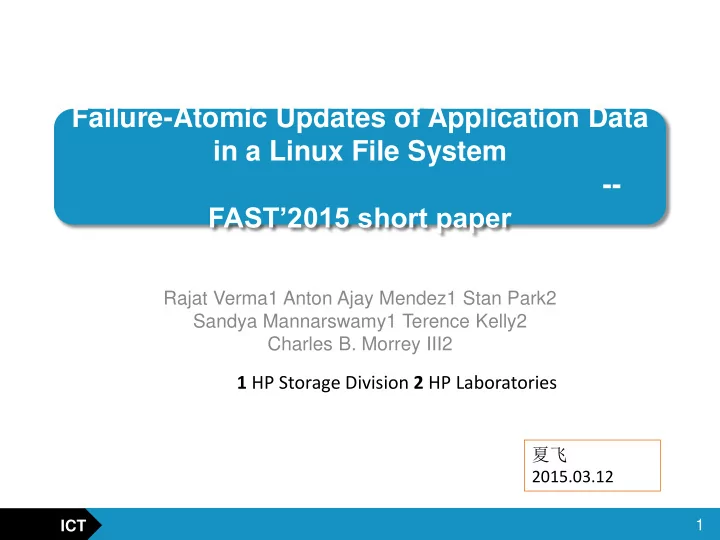

Failure-Atomic Updates of Application Data in a Linux File System -- FAST’2015 short paper Rajat Verma1 Anton Ajay Mendez1 Stan Park2 Sandya Mannarswamy1 Terence Kelly2 Charles B. Morrey III2 1 HP Storage Division 2 HP Laboratories 夏飞 2015.03.12 1 ICT
Outline • Introduction • Failure-Atomic Updates • Evaluation • Related Work • Conclusion 2 ICT
Introduction • Consistent modification of application durable data – DataBases and Key-Value stores • Transaction to guarantee ACID • Difficulties: data structure translation, complexity (implementation bugs) – File Systems • Usually guarantee metadata consistency • Data consistency (e.g., data journal mode in ext4): – Limitations: not interfaces for applications to specify units of atomic I/O [1] – Applications • File rename [2] [1]. Failure-Atomic msync(). EuroSys’2013 [2]. A file is not a file: Understanding the I/O behavior of Apple desktop applications. SOSP’2011 3 ICT
Overview • Goal – Provide failure-atomic updates of application data • Method – Single file atomic updates: O_ATOMIC flag – Multi-files atomic updates: syncv interface • Result – Correctness of O_ATOMIC – Performance: low overhead 4 ICT
O_ATOMIC (e) Close File inode The original file is replaced with the clone. Block 0 Block 1 Block 3 • Crash recovery – Check if the clone is existed when the file is accessed again – If exist, rename it 5 ICT
Multi-File Atomic Updates: syncv • Single file fsync/msync • syncv (fd0, fd1, …) – Need to guarantee the atomicity of deleting all the files’ clones – Method: journaling • Metadata modifications required to delete the clones are logged to the journal. fd0 fd1 Clone0 inode File inode Block 0 Block 1 Block 2 Block 3 6 ICT
Evaluation • Correctness of O_ATOMIC – Method: • Insert crash point into the AdvFS source code. • Cut power of a machine – Result: • Recovery successfully over 400 power interruptions and dozens of crash-points. 7 ICT
Performance • Platform: – Workstation: • 2 quadcore 2.4 GHz Xeon E5620 processors, 12 GB of 1333 MHz DRAM,Linux kernel 2.6.32 • 120GB SATA SSD – Server: • 12 1.8 GHz Xeon E5-2450L cores and 92 GB of DRAM; • 1 GB battery-backed cache configured as 90% write cache • 1 TB 7200 RPM SAS hard drive. 8 ICT
Performance • O_ATOMIC – Write data to a file followed by fsync 2ms overhead before writing 2 7 pages Reason: Reading inode from storage to clone with O_ATOMIC. 9 ICT
Performance • O_ATOMIC 10 ICT
Performance • Mesobenchmarks: 3,000 transactions – insert all keys paired with random1 KB values; – replace the value associated with each key with a different random value; – finally, delete all of the keys LevelDB > STL <map>/AdvFS > SQLite > Kyoto Cabinet 11 ICT
Related Work • Failure-atomic msync – Only apply to memory-mapped file – Data modifications are written twice due to journaling • Fusion-io atomic-write – Special hardware, only apply to single-file updates, cannot address updates to memory-mapped file • Vista Transactional FS (TxF) – Deprecated due to complex interface • Transaction OS (TxOS) – Implemented by FS journal: write twice, transaction size • Works on persistent memory – Mnemosyne: do not support conventional FS operations – Software persistent memory (SoftPM): 512KB granularity • CoW FS – Conventional: ZFS (bubbling up to the root) – Optimized: BPFS (short-circuit shadowing page) 12 ICT
Conclusion • Provide interfaces for applications to guarantee failure- atomic updates. – O_ATOMIC flag – syncv() • Simple and efficient 13 ICT
Recommend
More recommend